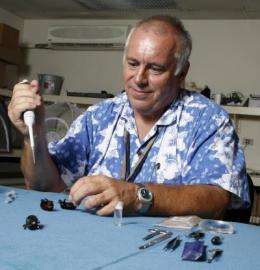Unusual rhino beetle behavior discovered

The coconut rhinoceros beetle continues to munch its way through the crowns of coconut trees on the northwest coast of Guam. Rhino hunters are ready to get tough with bio-control measures that will decrease the rhino beetle population.
Russ Campbell, Guam's territorial entomologist and Aubrey Moore, UOG extension entomologist, welcomed New Zealand scientist, Trevor Jackson to Guam in early June. Jackson was invited to assist in the release of a virus into the rhino beetle (Oryctes rhinoceros) population. This virus only infects rhino beetles and it has been successful in controlling populations of the pest on other Pacific islands.
The virus is naturally occurring in Malaysia and is produced in a New Zealand laboratory. It is dispersed using autodissemination: adult beetles are fed a solution of the virus, become infected, and then they are released to infect the resident population. This method of bio-control has been successfully used in Samoa, Fiji, Tonga, Palau and other Pacific islands where the rhino beetle was accidentally introduced. It will take several months to see the results. "The bio-control agent will not completely eradicate the CRB, but it will help to keep it under control," says Moore.
Aubrey Moore and his assistant Bob Bourgeois are been rearing rhino beetles individually in mason jars in order to have healthy beetles to infect with the virus. Hungry beetles are taken to the Guam Plant Inspection Facility, fed the virus, and then strategically released into island rhino populations. Once the beetles are infected, the virus damages their stomach walls causing them to stop eating.
During Jackson's visit the team discovered unusual rhino beetle behavior: the beetles were not breeding on the ground in decayed logs as normal; they were breeding in the detritus trapped in the tree branches. In cutting down 11 large coconut palms they found a complete ecosystem in the crowns including brown tree snakes, crabs, and, unfortunately, all life stages of rhinoceros beetles, from eggs to larva to young adults. This new discovery makes the release of the bio-control virus even more vital. Moore thinks this arboreal breeding behavior, seen only on Guam, may be due to the fact that the brown tree snake has wiped out most of Guam's rats. Elsewhere, rats love to live in coconut crowns, and they love to eat rhino beetle grubs.
This never-before-seen rhino beetle behavior of breeding in the crowns of coconut trees underscores an important point of invasive species on small islands. Their impact is often severe because there are no natural enemies, such as predators, parasites, or diseases, to control their population growth.
Provided by University of Guam















